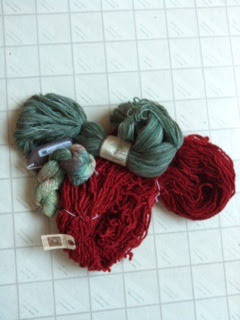Every self-respecting knitter or quilter has a precious reserve of yarn or fabric known as a “stash”. The stash is a source of pride, reassurance, and bragging rights. It’s where the artist turns for inspiration or for that spark of color or texture to add to a project. However, the stash can take on a life of its own, growing out of control like that sourdough starter we had during the 70s.
There are warning signs: Denial: “Oh that – just a little extra yarn I’m saving in case there’s a sheep plague, something like the Irish Potato Famine.” Projection: “I have a friend who bundles fabric to disguise it as pillows and furniture – she really has a problem.” Rationalization: “I might as well buy it now, because if I wait until I need it, it will just be that much more expensive.”
There are rational (note the root of the verb rationalize) reasons for stashing: Good quality yarn and fabric are expensive, so a good sale is hard to resist.
 |
| Sale Yarn |
There is also a little-known principle of physics that works against us: it takes significantly less time and effort to purchase yarn or fabric than it takes to wrangle said fiber into a sweater or quilt.
While there are no recorded instances of a stash becoming a "Little Shop of Horrors" life form and actually devouring its owner, when the stash achieves the size where it requires its own room and zip code, clearly something must be done. While quilters and knitters joke about their stash providing insulation in the case of an apocalyptic weather event, we all know there are limits. The stash that seemed like an asset in the past becomes a definite liability when one is considering moving, especially if downsizing. Suddenly, those beguiling colors and textures become overwhelming and oppressive.
The first step of reducing the stash might be a “yarn diet”. I’ve been on that diet for about a year, with no obvious shrinking of the stash, probably due in part to some diet exceptions I’ve allowed. First, yarn purchased to use with stash yarn to complete a project. This becomes a dilemma similar to the cereal and milk quandary. Eating a bowl of cereal always leaves about a quarter of a cup of milk in the bottom of the bowl, but if I add cereal, then it seems a little dry, and needs more milk, and so on and so on. Yarn is like that. Few patterns use up all the skeins needed, especially if a little extra was bought for good measure. Odd balls inevitably remain at the end of the project. Second, comes “souvenir yarn”.
 |
| Souvenir yarn from NYC, Salt Lake City, and Coer D'Alene |
Visiting a local yarn shop is a great way to explore a new city. Yarn shops are often located in interesting shopping districts and the staff is frequently a friendly source of advice about other local sites of interest. Sometimes souvenir yarn appears serendipitously – such as the skein I purchased at a farmers’ market in a sunny meadow of Manhattan’s Union Square. How could I not support a small family operation like C
atskill-Merino who produces such lovely skeins as this?
So, clearly, the yarn diet is not working. A more intense stash reduction program is necessary. I’m considering “hoarder-avoidance” therapy but haven’t found a counselor who lists “fiber management” as her field of expertise. The program of last-resort is a pact I have with my quilting and knitting friends. It goes like this: when a member of our group moves on to the yarn and quilt shop in the sky, her friends will converge upon her stash and subdivide it into fat-quarters and yarn bundles and distribute them at the wake. Suitable beverages will be provided.
In the meantime, I have found some simple patterns that can use a variety of partial skeins and leftovers. The sustainability principle I’m working on this year is “use up what you have.” Details will follow.



